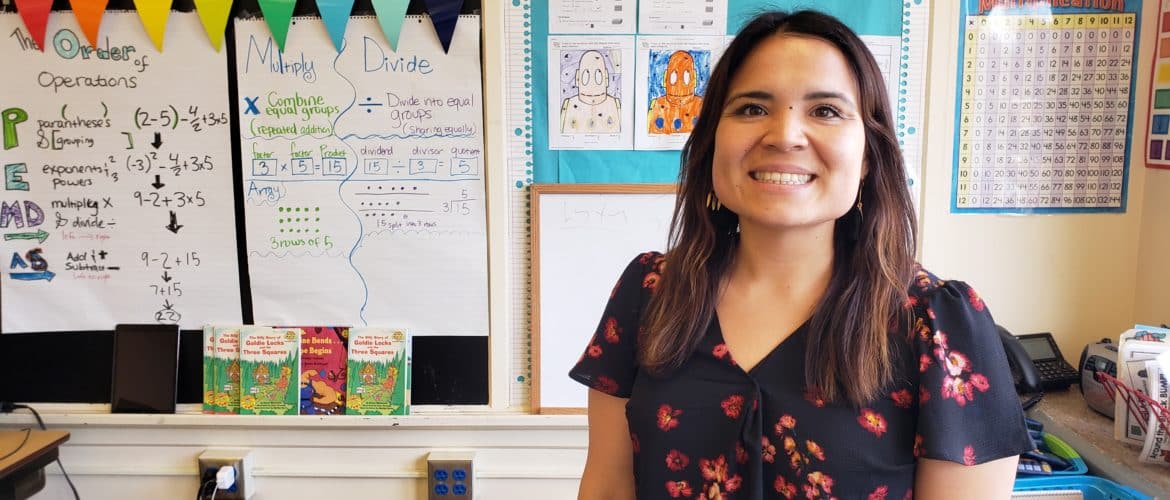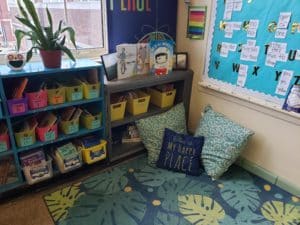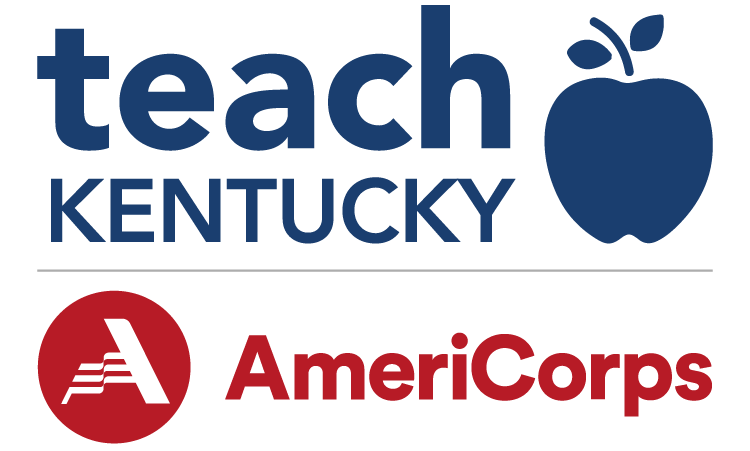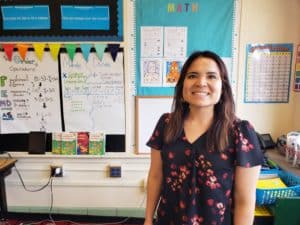TKY teacher builds bridges to take her students far

Teach Kentucky teacher Cassie Bastitas (2017 cohort) remembers what it’s like to be an English language learner in school.
“I have parents who immigrated to the States from Mexico,” she shares, “and I tell my students I understand that learning can be overwhelming when English is not their first language. I was a bit delayed myself on social skills when I was a child, and my students take comfort when I tell them I understand when they do not immediately master a concept.”
It works. “Students feel safe to make mistakes in my classroom,” she says.
Making Gains
It’s no coincidence that Cassie has had success with her special education students at Rutherford Elementary in JCPS. Her students have made gains academically and socially, and no doubt boosted by her students’ performance, Rutherford had the highest gains in the district for math last year.
In addition to empathizing with the needs of her students, Cassie attributes much of her success to the larger school community at Rutherford. At Rutherford Elementary, diversity is valued and teachers feel compelled to meet the individual needs of every child. Cassie describes the school as “one of the most diverse schools in Louisville. There are many students who are refugees, and I am always amazed by their stories. I love to be part of this environment.”
Building Bridges
Because she has been there before, Cassie understands the unique challenges of learning English, being part of an immigrant community, and having other learning challenges. From this understanding of her students, Cassie knows how critical it is to teach them to be resilient and take ownership of their learning.
Cassie shares about one student (we’ll call him Caesar) who immigrated to the United States from Mexico. Caesar’s mother died when he was young and his father has since been the main provider and caregiver in his family. Because Caesar’s father only speaks Spanish, Caesar must be the interpreter for the family.
Though Caesar’s spoken language skills are superior, he struggles in reading and writing. Cassie shares that he sometimes becomes discouraged. Cassie doesn’t let him give up, however, and pushes her students to have high expectations for themselves and embrace the struggle.
She elaborates, “I told him that reading and writing may be a struggle, but he can overcome them because he is brilliant. I told him that many Americans do not know two languages, and I have him teach math concepts to other students who were struggling. I remind him that he knows how to communicate well to his peers and teachers, and I told him that his character will take him places and that he is not measured by what he cannot do, but what he can do.”
Cassie also connects with her students’ families in order to build a supportive network around her students and inspire their achievement despite barriers, such as language, xenophobia and socioeconomic status.
Of Caesar’s father, Cassie shares, “His father works hard and wants his son and daughter to succeed in order that they will grow up to be successful in the United States. His father is a construction worker and Caesar would always mention how much of a hard worker his father is and how kind he is. I met his father and he is an amazing example of a person who perseveres through tragedy and hardship.” Expressing these sentiments to Caesar only inspires him to dig deeper and work harder to improve his written language skills to match his oral language.

Getting Gritty
Cassie’s focus on building her students’ resilience does not stop with her academic expectations, but encompasses the whole child. Her current passion project is implementing restorative practices, a methodology that teaches students to be aware of their social emotional health and how to address their own needs and build resilience. Cassie has specifically implemented a teaching curriculum that is called GRIT, which teaches students to grow in resilience in their learning and daily life choices.
“I was researching different methods in how to encourage my students to grow in making mistakes and persevering through the challenge,” Cassie explains. “Now, slowly but surely, I have had some students motivate themselves more in wanting to challenge themselves emotionally, mentally, and socially.”
How does this look in the classroom? Cassie has her students gather as a family in a circle every morning. The first order of business here is to raise fingers to tell the class our “temperature” from one to five. One finger means a student is feeling great, and five fingers mean a student is feeling awful; they are then invited to share why they feel that way.
This week, Cassie shares, “I had one student who held out his hand that he was feeling a five. I pulled him aside and told me that something happened at home. Usually, he would have reacted by disrupting class, but he felt that he could trust me and know that he can communicate his emotions to me and that I would understand.”
Because Cassie honors the feelings of her students and gives them an opportunity to acknowledge and take ownership of them, she has fewer behavior problems, greater trust and more academic growth.
Setting Goals
Looking toward the future, Cassie shares, “I hope that my students can gain more of an awareness that their character will produce success. I do not want my students to be only academically successful, but to be kind people who use their skills for others.”
As for her own career ambitions, Cassie seeks to lead from the classroom. “The older I get, the more I love and appreciate my Latino culture. I plan to get my English as a Second Language (ESL) endorsement and be an ESL teacher.”
Teach Kentucky and the larger community benefit from the diversity in perspective that teachers like Cassie bring to our program. As one of only three elementary school teachers and one of only five special education teachers, Cassie expands Teach Kentucky’s reach and broadens our impact.
It’s her students, though, who are the greatest beneficiaries.


